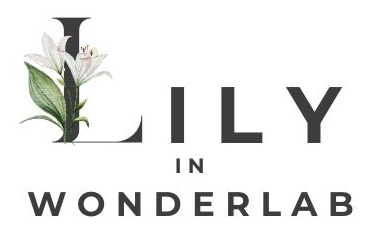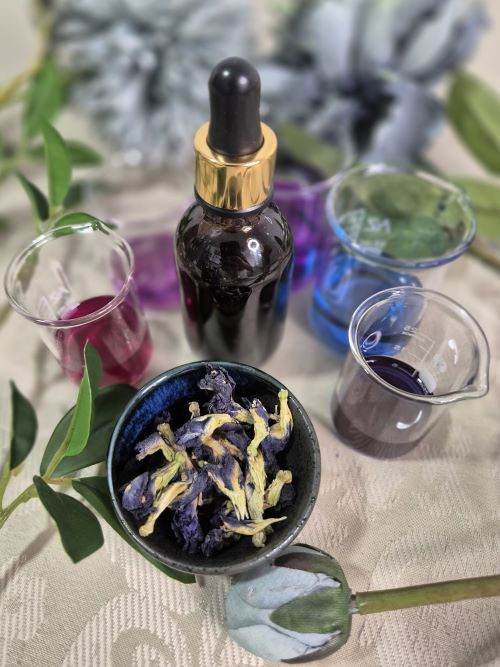Butterfly pea flower extract, derived from the Clitoria Ternatea plant, is a hidden gem in DIY skincare, offering a combination of stunning aesthetic properties and powerful skin benefits.
Its vibrant blue color, which magically shifts with changes in pH, has made it a favorite in drinks, but its potential goes far beyond beverages. This botanical treasure, like a flower gathered straight from a fairy tale, brings a splash of creativity and color to your cosmetics, transforming ordinary products into something magical and whimsical.
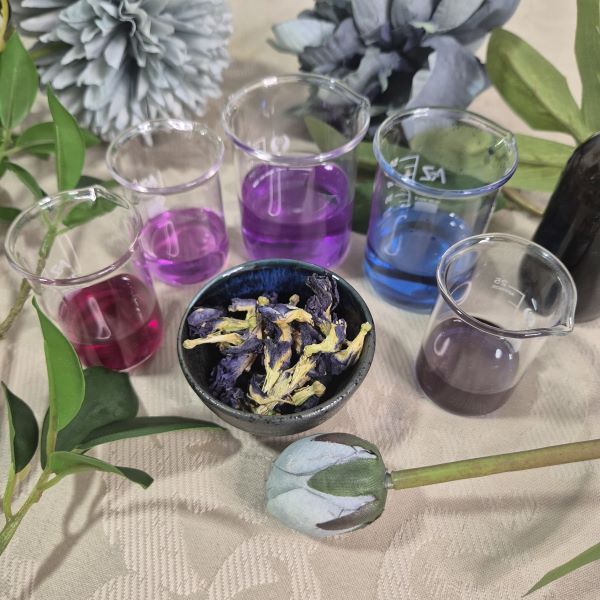
More than just a visual treat, butterfly pea flower extract is rich in antioxidants and anti-inflammatory compounds like anthocyanins, which help protect the skin from environmental stress while soothing irritation.
If you’re looking to add a touch of joy to your cosmetic formulas with its magical blue hue or looking for an ingredient with real skincare benefits, butterfly pea flower brings a versatile and enchanting touch to your creations. Its ability to transform ordinary formulations with something different, original and extraordinary sets it apart.
Keep reading to discover how to harness the power of this unique extract and infuse your products with beauty, poetry and effectiveness.
Butterfly Pea Flower Benefits for Skin
The benefits of butterfly pea flower for skin are linked to its high concentration of anthocyanins, which are responsible for its bright blue color. These compounds help neutralize free radicals, reducing the signs of aging such as wrinkles and fine lines. Additionally, butterfly pea flower has anti-inflammatory properties, which make it ideal for calming irritated or inflamed skin, reducing redness and promoting a more even complexion.
A Fairy Tale Ingredient for DIY Cosmetics
This flower, known for its pH-sensitive color-changing properties, is often used in beverages like teas and mocktails, but not many realize it can be just as magical in cosmetics. Its ability to shift from blue to purple or pink depending on the pH makes it a creative addition to water-based formulations and emulsions. For the best color results, use butterfly pea extract in white or transparent formulas to let the vibrant blue shine through. At a pH range of 5-6 (common in cosmetics), the extract remains blue, but it turns purple when the pH drops below 5.
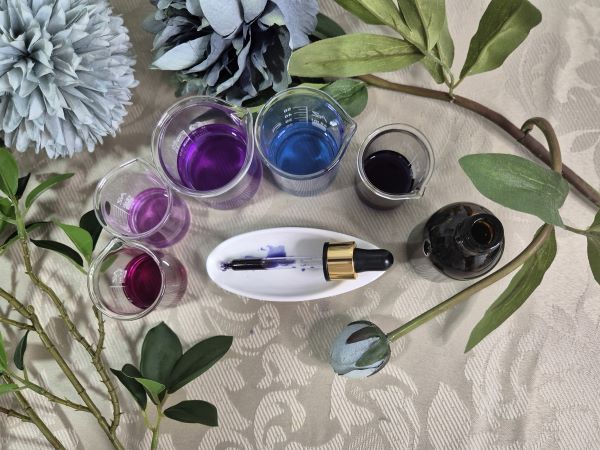
How to Make Butterfly Pea Flower Extract for Cosmetics
Creating your own butterfly pea flower extract at home is an easy process that allows you to harness its magical blue hue and skincare benefits, like antioxidant and anti-inflammatory properties. Follow this step-by-step guide and enjoy this lovely fairy potion!
Step 1: Prepare Your Solvent
Before you begin, choose the right solvent based on your needs:
- 50% Glycerin / 50% Water
This option is gentle and alcohol-free, making it ideal for sensitive skin. Glycerin is a humectant, helping to retain moisture and draw water into the skin. This combination works best for extracting anthocyanins from butterfly pea flower, which provide antioxidant and soothing benefits. While it's effective at extracting water-soluble compounds, it’s less efficient for pulling out fat-soluble components like certain flavonoids and terpenoids. Choose this solvent for a hydrating and anti age extract that's balanced and suitable for most skin types, or if you want to use it mainly for its color. Personally, I prefer this option.
Although this method is self-preserving, homemade extracts can be prone to contamination. To be on the safe side, consider adding a 0,6% of preservative like Cosgard or Isocide. It’s always better to be cautious with homemade DIY extracts! - 50% Alcohol / 50% Water
If you’re looking for a more potent extraction, go for it. Alcohol effectively extracts a broader range of compounds, including both water-soluble and fat-soluble elements like flavonoids and terpenoids. These compounds enhance the anti-inflammatory and antimicrobial properties of your extract. However, alcohol can be drying, so it’s not recommended for very sensitive and dry skin.
For example, if you want to make a 50% alcohol/50% water solvent, mix 50 g of water with 50 g of alcohol. The quantity of flowers and solvent depends on various factors like the plant and container size, but in general 100 g of solvent are enough for around 10-15 g of butterfly pea flowers (stop when you see that flowers are completely soaked, so the result will be less diluted). Keep in mind that even if you use 100 g of solvent, once filtered you’ll obtain much less as it’s absorbed by the plant.
Step 2: Grind the Butterfly Pea Flowers
For faster extraction, grind the dried butterfly pea flowers lightly to increase the surface area exposed to the solvent. Be careful not to over-grind, as this will make filtration difficult later. While this step isn’t necessary, it’s recommended for more efficient extraction.
Step 3: Add the Flowers to the Solvent
- Place the ground (or whole) dried butterfly pea flowers into a clean, sterilized glass container.
- Pour your chosen solvent (either the glycerin-water or alcohol-water mix) over the flowers until they are fully covered.
- Stir gently to ensure all the flowers are saturated with the solvent.
Step 4: Let It Soak
- Allow the flowers to soak in the solvent for at least 2 weeks, shaking the container every day to help with the extraction process.
- If you didn’t grind the flowers, consider leaving them to soak for 3-4 weeks for a more thorough extraction.
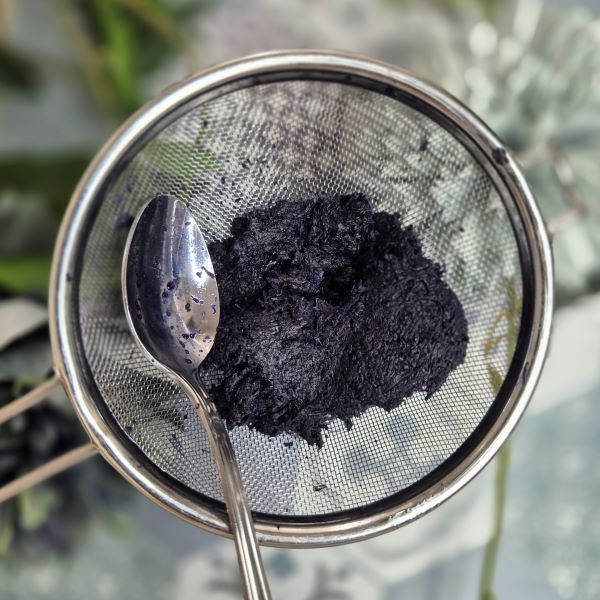
Step 5: Filter the Extract
- After 2-4 weeks, strain the larger pieces using a colander.
- For a clearer extract, pass the liquid through a finer filter, such as a coffee filter or a paper filter, to remove smaller particles. This step may take time but ensures a smooth extract.

Step 6: Bottle and Store
- Pour the filtered extract into a dark glass bottle to protect it from light exposure.
- Label the bottle with the date and store it in a cool, dark place. The extract will last up to 1 year if properly stored.
How to Use Butterfly Pea Flower Extract in Cosmetics
A little goes a long way when it comes to butterfly pea flower extract. If you’re using it primarily for its coloring properties, a few drops can give your water-based cosmetics a beautiful, intense blue. However, if you want to benefit from its antioxidant and anti-inflammatory properties, use it at a concentration of around 5%. This will give your DIY cosmetic a rich, deep blue color. While the extract doesn’t stain the skin, you’ll want to massage it carefully, especially in body applications, to avoid any transfer to clothing.
Where to Buy Butterfly Pea Flowers
Finding butterfly pea flowers may require a bit of searching, as they aren’t widely available in every store. You can often find them in specialty tea shops, gourmet stores, and some health food or herbal shops. Amazon has dried butterfly pea flowers as well. Be mindful to buy the dried flowers, rather than the powdered version (also called "blue matcha"), which is more suitable for culinary uses or bath bombs, but not ideal for making a cosmetic extract (also, the powder should NOT be added directly to emulsions or water based cosmetics).
Interested in more DIY extract? Try my honeybush extract recipe!

